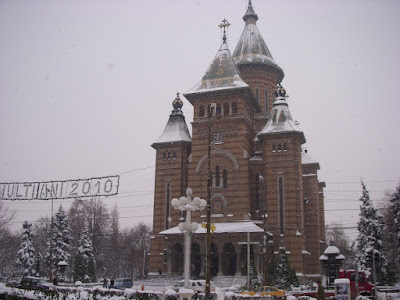Hometown - Timisoara
Some background for you:
Timisoara was first mentioned as a place in either 1212 or 1266. The territory later to be known as Banat was conquered and annexed by the Kingdom of Hungary in 1030. Timisoara grew considerably during the reign of Charles I, who, upon his visit here in 1307, ordered the construction of a royal palace. Timisoara's importance also grew thanks to its strategic location, which facilitated control over the Banat plain. John Hunyadi established a permanent military encampment here, and moved here together with his family. In 1552, Ahmed Pasha conquered the city with a 16,000 Ottomans and transformed it into a capital city in the region. The local military commander, Stefan Losonczy, was captured and beheaded on July 27, 1552 after resisting the Ottoman invasion with just over 2,300 men.
Timisoara remained under Ottoman rule for nearly 160 years, controlled directly by the Sultan and enjoying a special status, similar to other cities in the region such as Budapest and Belgrade. During this period, Timisoara was home to a large Islamic community and produced famous historical figures such as Osman Aga of Temesvar, until Prince Eugene of Savoy conquered it in 1716. Subsequently, the city came under Austrian rule, and it remained so until the early 20th century except Ottoman occupation between 1788-1789 during Ottoman-Hapsburg war. During this time, Timisoara evolved from a strategic fortress to an economic and industrial center: numerous factories were built, electric illumination and public transport were introduced, and railroad connections were established. The city was defortified, and several major road arteries were built to connect the suburbs with the city center, paving the way for further expansion of the city limits.

It was the first mainland European city to be lit by electric street lamps in 1884. It was also the second European and the first city in what is now Romania with horse drawn trams in 1867. Gustave Eiffel, the creator of the Eiffel Tower in Paris, drew the projects of one of Timisoara's footbridges over the Bega.
On October 31, 1918, local military and political elites establish the "Banat National Council", together with representatives of the region's main ethnic groups: Hungarians, Romanians, Serbs and Germans. In the aftermath of World War I, the Banat region was divided between the Kingdom of Romania and the Kingdom of Serbs, Croats and Slovenes, and Timisoara came under Romanian administration after Serbian occupation between 1918-1919. In 1920, King Ferdinand I awarded Timisoara the status of a University Center, and the interwar years saw continuous economic and cultural development.
During World War II, Timișoara suffered damage from both Allied and Axis bombing raids, especially during the second half of 1944.
After the war, the People's Republic of Romania was proclaimed, and Timisoara underwent Sovietization and later, systematization. The city's population tripled between 1948 and 1992. In December 1989, Timisoara witnessed a series of mass street protests by Romanians, Hungarians and Serbs, in what was to become the Romanian Revolution of 1989, the beginning of the democratic movement.
And now this is the face of my hometown!





There are no words to describe my town, it is home, pure and simple!
P.S. Wikipedia was my source :)














